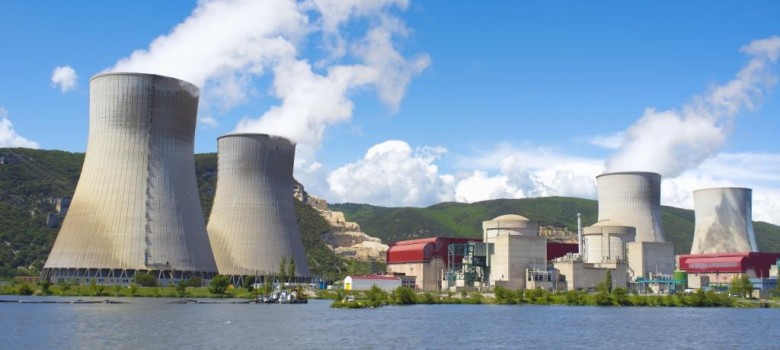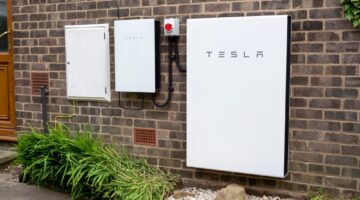
Nuclear Power in the UK
Nuclear power began here in 1956 when the Queen officially opened the first nuclear power plant in Calder Hall, Cumberland. Today there are only a few plants remaining in the UK.
Nuclear Fission – The Science Behind Nuclear Power
When people refer to nuclear power today, they are referring to the process of nuclear fission. There is another process called nuclear fusion, which would be our energy game-changer, providing limitless cheap energy – unfortunately this has yet to become reality.
To understand nuclear fission, first you need a basic understanding of chemistry:
An atom of any material is made up of three simple types of subatomic particle; protons, neutrons and electrons. Protons and neutrons are found in the nucleus of an atom, while the electrons whizz round the nucleus like orbiting moons. These electrons in comparison are incredibly small and carry a negative charge. The protons carry a positive charge and the neutrons are – as the name suggests – neutrally charged.
The number of protons determines what element an atom is, and the number of electrons normally equals the number of protons, to balance the charge across the atom. In the nuclei of lighter elements, the number of protons and neutrons is normally fairly equal too, but as you move down the periodic table the balance begins to change. The heaviest elements have a disproportionately high number of neutrons, and to fuse lighter elements together to create the heavier elements takes an enormous amount of energy (the sort of energy released when stars explode). This means that the chemical bonds in these elements hold an incredible amount of energy, which can be released and harnessed to make electricity.
The heavier the atom, the less stable the nucleus; therefore by firing a neutron at the atom, we can disrupt the delicate balance of the nucleus, causing it to break down into more stable, lighter atoms. This process will release all the energy required to make the atoms in the first place. This is the basis of nuclear energy, and this process is called nuclear fission.
Uranium-235 in Nuclear Fission
A neutron, (a subatomic particle) is fired at a nucleus, which is then absorbed by the nucleus resulting in the creation of an unstable isotope (an isotope simply means the same number of protons, but a different number of neutrons), which in turn splits into lighter nuclei that are different from the parent atom and neutrons. This reaction creates an enormous amount of heat, one that can be used to turn water into steam, which can drive a generator and create electricity. The neutrons produced in the fission reaction can be captured by other atoms so further reactions could take place (known as a chain reaction) with more neutrons produced each time fission takes place, so that the reactions become self-sustaining.
Fissile isotopes are isotopes of an element that can be split through nuclear fission, and only certain isotopes of certain elements are fissile. Uranium is the main element used in nuclear reactors (and atomic bombs), with uranium-235 being the specific isotope used. When a neutron strikes the uranium-235 isotope, it is initially absorbed creating the unstable isotope uranium-236, which then causes the atom to split (fission). The fissioning of this atom can produce over 20 different products. However the resulting product masses when added up, always add up to 236, with the one, extra, additional neutron that drives this chain reaction process.
How we harness Fission today in Nuclear Power Plants
The majority of nuclear power today is produced within light water reactors (LWR), which work in a relatively simple way. Hundreds of long, thin zirconium rods are filled with pellets of uranium oxide, lightly enriched with a 5% concentration of uranium-235, far less than the 90%+ enrichment needed for a weapon. The rods are placed closely together in the reactor core. When a free flying neutron strikes the nucleus of a uranium-235, the binding energy that holds the nucleus together is released as the atom splits (fissions) into two smaller, unstable nuclei, called fission products.
As they fly away, one or more neutrons are ejected as well. Some of them bombard the nuclei of other uranium-235 atoms, causing them to fission, and that’s your basic chain reaction. 80% of the energy released by the reaction is accounted for by the kinetic energy within the fission products, which when hit nearby atoms release a serious amount of heat.
This heat is removed from the rods using fast flowing water, which can be used to drive turbines producing electricity. LWRs operate at about 3200C, which is well above the boiling temperature of water, so a great deal of pressure has to be applied to keep the water liquid, and if the water cooling stops, the fission will stop.
However, in addition to kinetic energy, the fission products also produce decay heat, and this is how meltdowns occur. If the rods aren’t cooled, this decay heat builds up causing the nuclear plants to go into meltdown. A meltdown is when the fuel elements begin to melt, allowing the nuclear fuel to leach into the coolant, potentially allowing long half life radioactive materials to enter the environment. A great deal of work is currently being carried out on nuclear plant safety though, which is concentrated on minimising risks of meltdowns.
Nuclear Power Industry development
Proponents of nuclear energy contend that nuclear energy is a sustainable energy source that reduces carbon emissions and increases energy security by reducing our dependence on energy harnessed from fossil fuels. Nuclear power can also produce the base-load power, unlike many renewable forms such as hydroelectric, wind and solar power plants, which are intermittent.
Opponents believe that nuclear power poses threats to people and the environment including processing, transport and storage on nuclear waste and the threat of serious nuclear accidents. The most important recent event that tipped the tide against more nuclear power was the Fukushima disaster in Japan, 2011. However, due to the potential energy crisis that may hit various parts of the world as supply is outstripped by demand, nuclear power has the potential to prevent this becoming an issue.
To counter this, plant and reactor investment required is still very capital intensive, especially in these economic times where low cost financing is harder to obtain. In summary, if you are a company looking to invest in nuclear power, you must note that there are large financial and regulatory barriers to consider. Financial costs include start-up costs, maintenance costs and decommissioning costs at the end of the plant lifecycle. Regulatory barriers also exist, as the industry is regulated for health and safety above anything else. In the UK this service is performed by the Office for Nuclear Regulation, which is part of the Health and Safety Executive.
Nuclear Power development in the UK
The DECC policy with regards to nuclear power is to support development in the UK, which means supporting new nuclear stations being built and using existing financial resources to subsidise the clean up and decommissioning of existing reactors. According to the Nuclear Decommissioning Authority some £2.3bn per annum is provided by DECC to continue the clean-up process. In terms of scale, this is now calculated as being over 50% of the department’s annual budget.
From this summary you can see that the public is still paying for the true cost of nuclear power and why many commentators are now sceptical whether the private sector has taken all these costs into consideration when looking to invest in new power stations. By 2025, most of the existing nuclear reactors would have been decommissioned and the 20% of electricity currently provided by nuclear will have to be replaced by more nuclear or some other form of generation.
With financial pressures and social uncertainties towards nuclear, we saw in March 2012, E.ON and RWE Npower pulling out of a series of projects to build nuclear reactors capable of generating 16GW of power. This had followed SSE’s announcement in September 2011, which was to promise a complete pull out of the nuclear sector and concentrate its assets on renewables and carbon capture & storage (CCS) technology.
If nuclear power investment doesn’t happen soon or be replaced by another form of renewable energy, we may see as in Germany and Japan (who have taken steps to reduce nuclear), an increase in fossil fuel electricity generation, as renewables like wind and solar power plants are simply not growing fast enough to satisfy the energy gap.
On balance it is difficult to say whether nuclear investment will happen in the UK based on the consideration of cost, risk and future social legacy. Different commentators give different points of view. The Committee on Climate Change found: ’nuclear is potentially the cheapest of all low-carbon options available until 2030’. However, the historical example shows that the current generation may still be paying for a good consumed 20-30 years ago, which then becomes the true cost, and one not quoted previously.












No Comments yet! Be the first one.